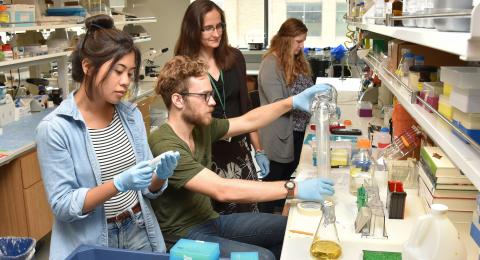NSF grant supports Oswego professor’s, undergraduates’ study of cell movement
Office of Communications and Marketing
Published
Thanks to a nearly $300,000 National Science Foundation grant, undergraduate researchers, starting this summer, are working with Dr. Yulia Artemenko of SUNY Oswego's biological sciences faculty to investigate how single cells determine where to move, which could have implications for why cancer cells metastasize -- migrate away from a primary tumor.
The three-year NSF Research in Undergraduate Institutions (RUI) grant supports Artemenko's and her students' efforts to use a model organism, a social amoeba, to study the molecular pathways that allow cells to move in response to different triggers, as well as the role of cell attachment to a surface in recognizing some of those triggers. These processes are highly analogous to what happens to cells in humans with cancers and other diseases.
"All the research we do in this study is driven by undergraduate students," Artemenko said. "With an RUI grant, the focus is different. There is a lot of focus on training students to become better scientists."
The project -- "RUI: Molecular Interplay Between Cell Adhesion and Directed Migration" -- also will fund collaborative visits from researchers at Johns Hopkins University and the University of Groningen in the Netherlands. Two students will accompany Artemenko next summer to Johns Hopkins, where she did post-doctoral work after earning her Ph.D. at University of Ottawa.
This summer, biology majors Bianca Fernandez, Jack Marcucci and Swin Ratnayake, all seniors, have joined junior Allison Hearn to learn painstaking laboratory skills, the use of advanced equipment such as SUNY Oswego's powerful confocal microscope, and to perform the analytical research and writing that will lead to new understanding, conference presentations and publications. They are paid by the new grant or, in the case of Marcucci and Hearn, by existing sources of funding such as SUNY Oswego’s Faculty-Student Challenge Grant and the NSF STEP program.
"I have learned a lot of technical skills -- biochemical-related ways to analyze what's going on in the cells," said Marcucci, who, like his colleagues, has assisted Artemenko for more than a year. "I've also learned how to write a grant, how to communicate not only with supervisors, but with other scientists, and how to give presentations."
'Ah-ha moment'
Ratnayake went to a college in Sri Lanka that has a collaborative relationship with SUNY Oswego, and learned about Oswego's hands-on, research-intensive opportunities. He said he hopes to move on the graduate school in bioinformatics.
Hearn said she has learned to use the college's Zeiss LSM700 confocal microscope, with an attached pump that enables the researchers to flow a fluid over amoeboid cells to study specific mechanisms that induce cells to move. Thanks to fluorescently labeled bio-sensors, the microscope also enables users to visualize individual cells and follow their movements.
Having extended lab experiences such as this project not only gives undergraduates advantages in applying to graduate schools, but also in deciding whether a research-intensive career is for them, said Artemenko. She finds working with the new investigators fun.
"Oftentimes, it's their first experience at real research," she said. "I love the ah-hah moment in students when they've been trying to understand something and suddenly see."
Fernandez cited another plus: "This research has helped me in my labs in other classes."
Marcucci said he did not anticipate being able to do this level of lab work in college.
"When I applied here, I was not aware that scientific-based research could go on at an undergraduate level," he said. "I think for the most part this work will define my undergraduate career, much more than I anticipated."
For more information on the biological sciences at SUNY Oswego, visit oswego.edu/biology.



